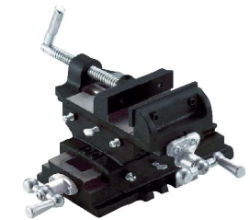What Is a Cross Vise?

A cross vise is a tool designed to firmly hold a workpiece in place while allowing movement along the X-axis and Y-axis.
Also known as a cross slide vise, cross sliding vise, 2-axis slide cross vise, cross flat table vise, cross flat bench vise, X-Y vise, and 2-way X-Y bench clamp, its unique feature is the ability to move a secured material. Unlike a standard vise, cross vises allow precise positioning horizontally but do not adjust vertically. It’s crucial to choose a cross vise of suitable height for the task.
Uses of Cross Vises
Cross vises are mainly used with drilling machines for creating holes in materials. Their ability to move the workpiece along the X and Y axes eliminates the need to reposition it manually for each hole, enhancing efficiency. When combined with an end mill, a drilling machine equipped with a cross vise can function as a basic milling machine.
However, drilling machines, designed primarily for vertical drilling, may not handle horizontal loads well, risking tilt or detachment of the drill chuck. Vibration can also increase, reducing cutting precision, especially in hard materials.
Principle of Cross Vises
A cross vise consists of a clamping part for securing the workpiece, and two sliding parts for X-axis and Y-axis adjustments, each controlled by a handle. This design facilitates easy operation, with the clamping handle on the left, the X-axis sliding handle on the right, and the Y-axis sliding handle at the front.
How to Select Cross Vises
Consider the following when choosing a cross vise:
1. Size
Select a size compatible with both the drilling machine and the workpiece. Ensure the height is compatible with your drilling machine setup.
2. Accuracy
Accuracy levels vary, affecting price. Choose based on the precision required for your projects, with higher accuracy typically commanding a higher price.
3. Travel Width
Travel width options range from 100mm to 200mm. Larger travel widths allow for processing bigger materials more efficiently, though they are generally more expensive.
4. Mouth Width and Depth
The dimensions of the vise’s mouth determine the size and thickness of the material it can hold. Choose a cross vise with dimensions that suit your material processing needs.